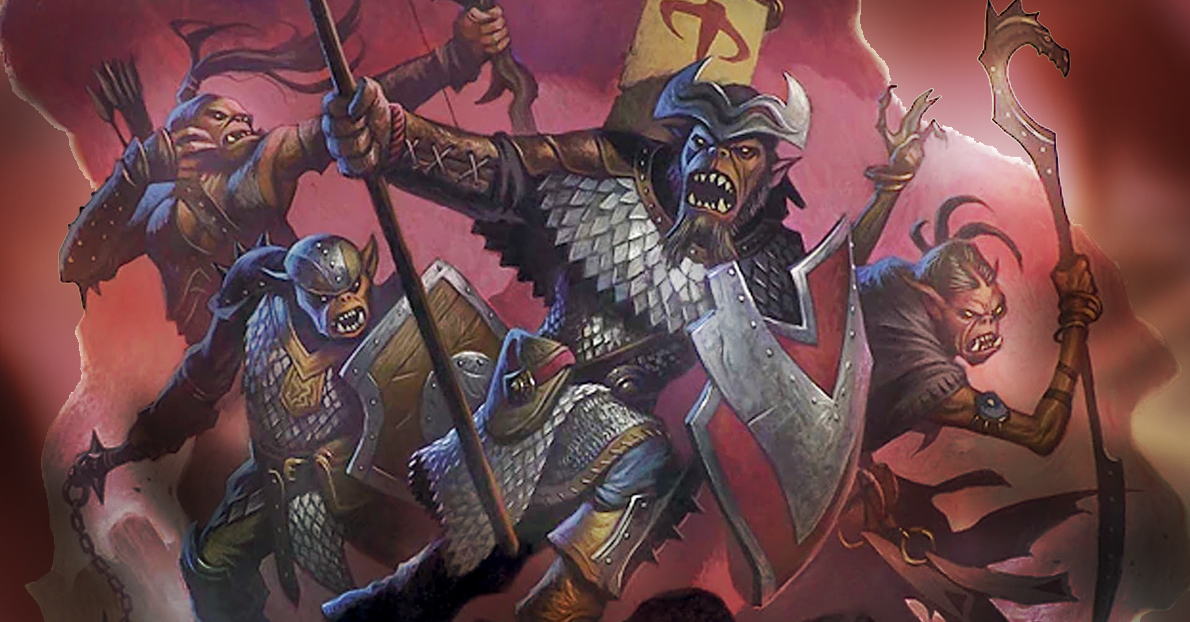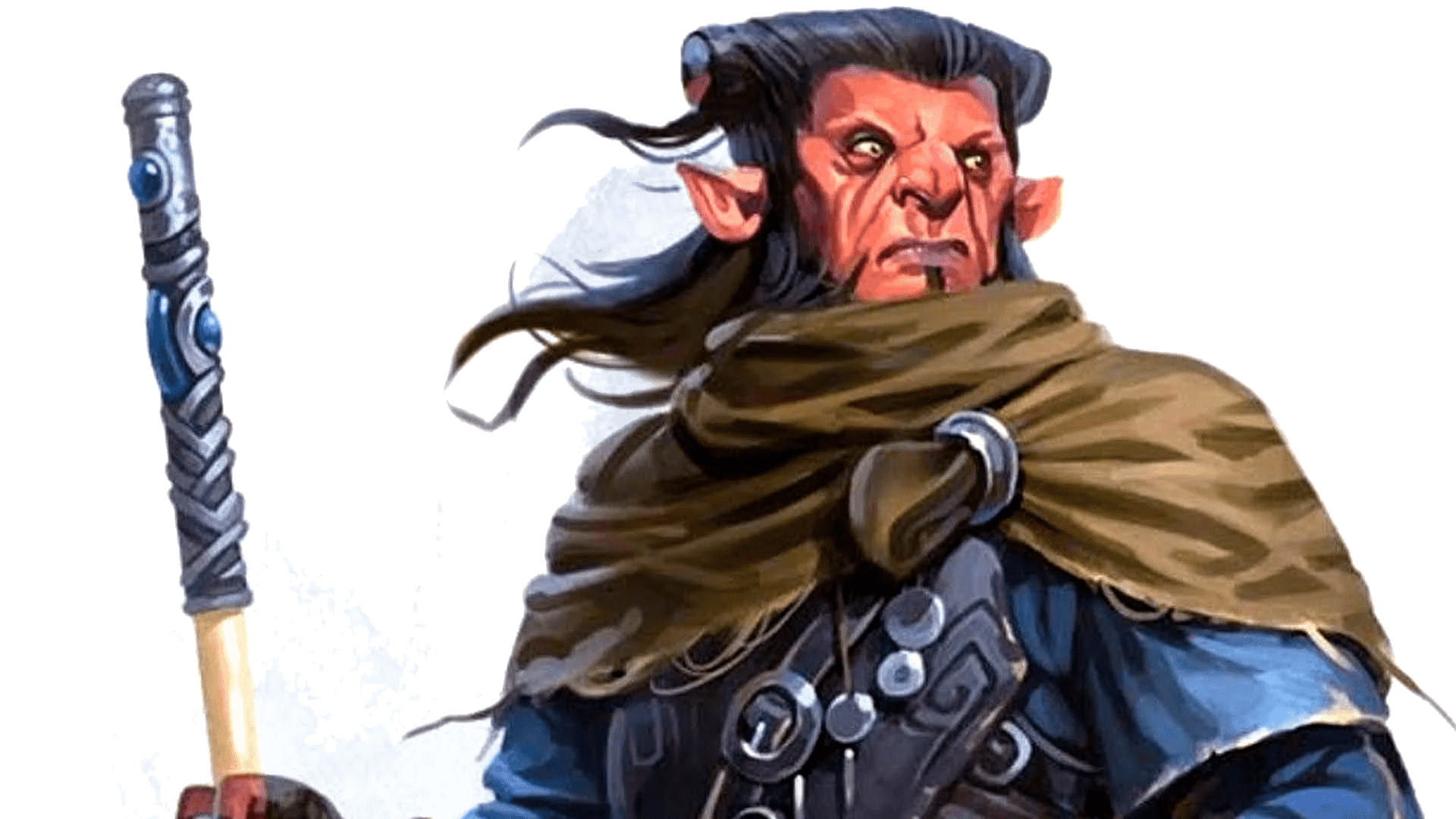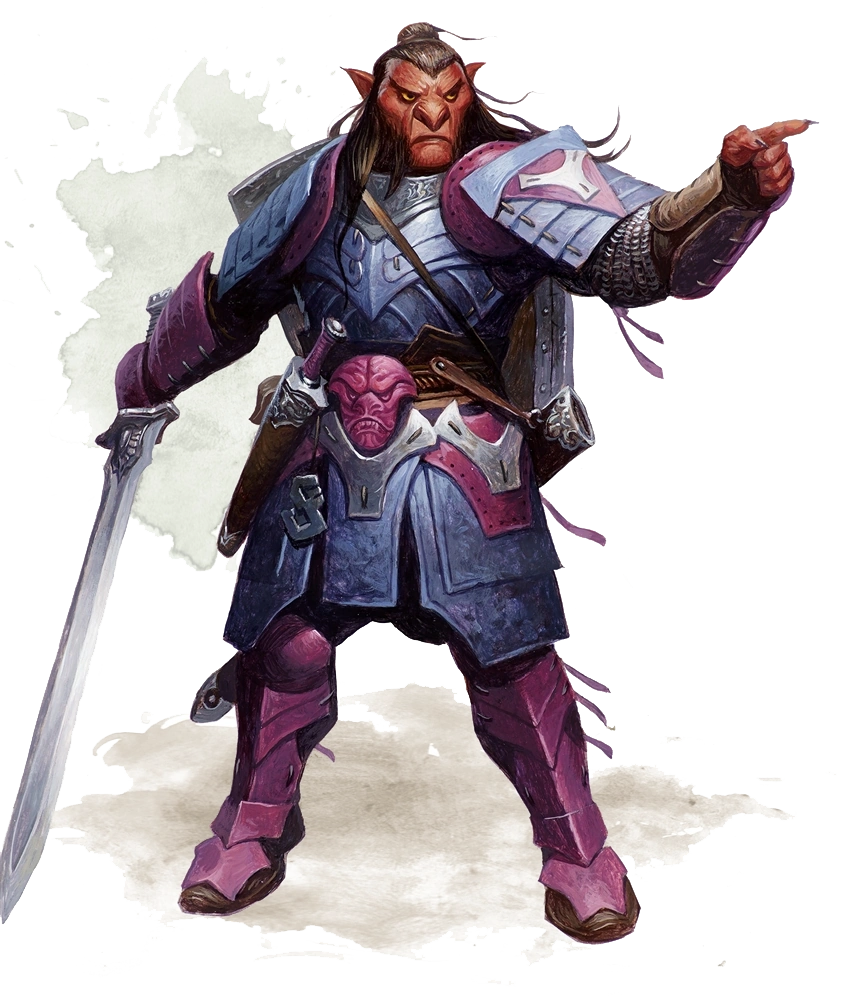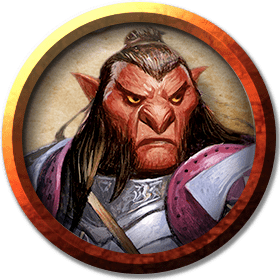Hobgoblin (/ˈhɑːb.ɡoʊ.blɪn/)
“They break before our shields, They fall beneath our blades; Their home is ours to conquer, Their children our slaves. Acheron! Acheron! Victory is ours!”
The Mighty Menagerie have met and fought many Bugbears. Many of which were part of the Blood Hand Orcs.
Basic Information
Anatomy
Ecology and Habitats
Behaviour
Personality
“Hobgoblins are relentless soldiers that cleave to rigid tactics and orders. I fear their less-predictable scouts and spies more.”By and large, hobgoblins, like their kin, were considered to be evil creatures and often met this expectation. While Goblinoid society was typically cruel and harsh, some individuals escaped it to carry on lives of virtue. The few who took this risk and succeeded often met cautious praise and acceptance from outsiders. Those that managed to escape Goblinoid society, however, were continuously plagued by their Goblinoid nature. Though hobgoblins were not necessarily evil, they were prone to violence and hot tempers, and often found it difficult to be truly altruistic. When provoked, which was not a hard task, hobgoblins were vindictive creatures who took glee in causing pain to those that injured them. Those hobgoblins who overcome this nature often managed this because of the rewards they found in serving good, rather than evil.
Additional Information
Social Structure
Society
“Hobgoblins have a code of honor. Its details vary from legion to legion, but it's always brutal.”Hobgoblins were mostly found in communities where they were in command of either goblins or bugbears, or sometimes both. The most civilized Goblinoid communities were ruled by the race. This was in large part because hobgoblin society was more industrious and less savage than that of goblins or bugbears. Though bugbears sometimes took control due to their raw strength, most such communities were ruled over by the strongest hobgoblin, who served as the warchief. Hobgoblins had a long tradition of mastering and breeding the creatures of the world into slaves of various sorts. Many, for instance, enjoyed working with wolves or worgs. Similarly, many drake breeds were first bred by hobgoblins. Some even believed hobgoblins carried this practice on within their own race, creating the goblins and bugbears in such a manner. Hobgoblins were immensely protective of their tribe's reputation and military status, so much so that meetings between different groups could turn violent if proper protocol was not followed. However, though hobgoblin tribes were territorial and egotistical in nature, they often united for a common purpose, such as war against non-goblinoids.
Hobgoblin Devastator
In hobgoblin society, the Academy of Devastation identifies hobgoblins with a talent for magic and puts them through a grueling training regimen that endows them with the ability to call down fireballs and other destructive magic on the host's behalf. A hobgoblin devastator on the battlefield is simultaneously a boon to all its allies and a threat to every foe around it. Into the Fray. While other cultures treat their wizards as cloistered academics, hobgoblins expect their spellcasters to fight. Devastators learn the basics of weapon use, and they measure their deeds by the enemies defeated though their magic. Devastators have the respect of other members of the host, and they receive obedience and deference from many quarters. Their ability to lay waste to entire formations with a single use of magic allows them to gain far more glory in battle than a single warrior. Other cultures might view the use of such abilities as a short cut to glory, but to hobgoblins a gift for magic is as valued and useful as a strong sword arm or brilliance in tactics. They are all boons from Maglubiyet that must be cultivated and unleashed upon the enemy. The Academy of Devastation believes that an academic approach to magic is a sign of weakness and inefficiency. A warrior doesn't need to know about metallurgy to wield a blade, so why should a Wizard care about where magic comes from? Devastators love to prove their superiority in battle by seeking out enemy spellcasters and destroying them. Only Results Matter. Devastators study a simplified form of Evocation magic. Their training lacks the theory and context that other folk study, making them skilled in battle but relatively illiterate on the finer points of how and why their magic works.Hobgoblin Warlord
Warlord is the highest rank a hobgoblin can be rewarded. These creatures rule over entire legions of hobgoblins and lead them into battle. More than anything, these creatures are ruthless tyrants bent on dominion and glory. Hobgoblins, in general, are the strongest of the goblinoid creatures. Warlords specifically will be outfitted in the best armor available to their clan. This armor and any clothing they wear is adorned in the colors of the clan, often dark red tones. While they don’t have much care for ornate imagery, rough symbols will often be associated with a legion, and a warlord may even have a specific symbol or piece of armor that denotes them as a leader. The entire appearance of hobgoblins carries through on one very important message: hobgoblins are ruthless, but they are not savages.Uses, Products & Exploitation
Harvesting
Instructions| DC | Item | Description | Value | Weight | Expiration | Crafting |
|---|---|---|---|---|---|---|
| 5 | Hobgoblin Ear | A hobgoblin's ear has little practical use. However, most communities will offer a bounty for showing proof of killing such creature. | 2 sp | 1 lb. | 14 days | - |
| 10 | Hobgoblin Captain/Devastator/Warlord: Hobgoblin War Braid | War-hardened hobgoblin veterans grow a long strand of hair to show their victories. Long braids signified a long life of fighting. And with every victory, the hobgoblin would add another knot and decoration. Powerful warriors had extremely long braids, full of beads, jewelry and small ornate bones. These braids fetch a good price in most markets. | 1 gp | 1 lb. | ∞ | - |
| 10 | Hobgoblin Warlord: Mark of Maglubiyet | When a hobgoblin becomes a warlord, they undergo a ritual to receive the blessing of Maglubiyet, the chief goblinoid deity. During this ceremony, they receive a brand with Maglubiyet's symbol (a bloody axe). This symbol can be harvested by carefully flaying the skin around the tattoo, which often rips the skin and ruins the mark. The mark is valued by collectors and goblinoid hunters. The mark also has a touch of arcane power, useful to artificers and spellcasters. | 5 gp | 2 lb. | 5 days | Amulet of Maglubiyet (HHH) |
This kind of creature may carry a few coins. This kind of creature may have a small hoard. This character usually carries: 1 Longsword, 1 Longbow, 1d6 Arrows, 1 Quiver, 1 Shield, 1 Chain Mail Random loot, generally very little. they can be carrying weapons and armor which could range in quality and abilities.
Possible Trinkets
Possible trinkets
1d12 Item Weight Value 1 1 thin rope threaded through several elf ears -- -- 2 1 bent signal whistle (unusable) -- 5 sp 3 1 crudely drawn battle map detailing an attack plan -- -- 4 1 crude wood carving of a warrior 1 lb. 9 cp 5 1 pouch of several chess pieces 1 lb. 7 cp 6 1 pouch of jewelry (stolen) 3 lb. 15 gp 7 1 stone medallion engraved with a bloody axe (symbol of Maglubiyet) 2 lb. 8 sp 8 1 pouch of chewing tobacco 2 lb. 3 sp 9 1 parchment outlining a troop schedule and regimen -- -- 10 1 human skull carved into a flagon 6 lb. 3 sp 11 1d4 dried meat ration(s) 2 lb. 5 sp 12 1d4 small animal carcass(es) 1 lb. 1 sp
This creature produces 2-12 pieces of Harvested Meat, weight total of 8-48 lb. DC: 5, Expire: 1 day, Value: 4-24 sp There is a stigma to eating meat belonging to sentient creatures that have a humanoid form and features. Harvesting the meat may be frowned upon and even considered cannibalism. Some communities may refuse to buy the meat (and some evil communities may pay a premium). The meat may even be difficult to eat, or unedible. Of course, these are all up to the Dungeon Master to decide.
Civilization and Culture
Historical Figures
Notable Hobgoblins
Ardenor Crush,
leader of the mercenary company known as the Chill.Dror Ragzlin,
the hobgoblin True Soul of the Absolute.Maaqua,
queen of the Razor Heart tribe in the Giantspire Mountains.Yargoth the Breaker,
head of the clan that dwelled within Trobriand's Graveyard.Common Myths and Legends
Religion
Hobgoblins once had their own pantheon, however, Maglubiyet, the god of war and rulership, killed most of the gods. Since then, he was the chief deity of hobgoblins. However, Nomog-Geaya, the deity of war and authority, was considered their patron deity, and many followed Bargrivyek.Magic
Hobgoblins were warriors by nature and prefered martial combatants to those who draw on magic. Those few spellcasters who were to be found were expected to work well with soldiers.Sources
Source(s):
- Mike Mearls, Jeremy Crawford, Christopher Perkins (2014-09-30). Monster Manual 5th edition. Edited by Scott Fitzgerald Gray. (Wizards of the Coast), pp. 184–187. ISBN 978-0786965614.
- Mike Mearls, et al. (November 2016). Volo's Guide to Monsters. Edited by Jeremy Crawford, et al. (Wizards of the Coast), pp. 161–162. ISBN 978-0786966011.
- Rob Heinsoo, Logan Bonner, Robert J. Schwalb (September 2008). Forgotten Realms Player's Guide. (Wizards of the Coast), p. 20. ISBN 978-0-7869-4929-8.
- Skip Williams, Jonathan Tweet, Monte Cook (July 2003). Monster Manual v.3.5. (Wizards of the Coast), pp. 153–154. ISBN 0-7869-2893-X.
- Doug Stewart (June 1993). Monstrous Manual. (TSR, Inc), p. 191. ISBN 1-5607-6619-0.
- Gary Gygax (December 1977). Monster Manual, 1st edition. (TSR, Inc), p. 52. ISBN 0-935696-00-8.
- Mike Mearls, Jeremy Crawford (2014). Player's Handbook 5th edition. (Wizards of the Coast), pp. 29–31. ISBN 978-0-7869-6560-1.
- Mike Mearls, et al. (November 2016). Volo's Guide to Monsters. Edited by Jeremy Crawford, et al. (Wizards of the Coast), p. 119. ISBN 978-0786966011.
- Mike Mearls, et al. (November 2016). Volo's Guide to Monsters. Edited by Jeremy Crawford, et al. (Wizards of the Coast), pp. 45–52. ISBN 978-0786966011.
- Mike Mearls, Stephen Schubert, James Wyatt (June 2008). Monster Manual 4th edition. (Wizards of the Coast), p. 135. ISBN 978-0-7869-4852-9.
- Mike Mearls, et al. (November 2016). Volo's Guide to Monsters. Edited by Jeremy Crawford, et al. (Wizards of the Coast), p. 47. ISBN 978-0786966011.
- Mike Mearls, et al. (November 2016). Volo's Guide to Monsters. Edited by Jeremy Crawford, et al. (Wizards of the Coast), p. 49. ISBN 978-0786966011.
- Mike Mearls, Stephen Schubert, James Wyatt (June 2008). Monster Manual 4th edition. (Wizards of the Coast), p. 140. ISBN 978-0-7869-4852-9.
- Mike Mearls, et al. (November 2016). Volo's Guide to Monsters. Edited by Jeremy Crawford, et al. (Wizards of the Coast), p. 46. ISBN 978-0786966011.
- Bruce R. Cordell, Ed Greenwood, Chris Sims (August 2008). Forgotten Realms Campaign Guide. Edited by Jennifer Clarke Wilkes, et al. (Wizards of the Coast), p. 180. ISBN 978-0-7869-4924-3.
- Tim Beach (1992). Gold & Glory. (TSR, Inc), p. 19. ISBN 1-56076-334-5.
- Larian Studios (October 2020). Designed by Swen Vincke, et al. Baldur's Gate III. Larian Studios.
- Bruce R. Cordell, Ed Greenwood, Chris Sims (August 2008). Forgotten Realms Campaign Guide. Edited by Jennifer Clarke Wilkes, et al. (Wizards of the Coast), p. 161. ISBN 978-0-7869-4924-3.
- Christopher Perkins (November 2018). Waterdeep: Dungeon of the Mad Mage. Edited by Jeremy Crawford. (Wizards of the Coast), p. 117. ISBN 978-0-7869-6626-4.
5E Statistics
 Hobgoblin
Hobgoblin
| Size | Medium |
| Type | Humanoid |
| Tag(s) | Goblinoid |
| Alignment | Lawful Evil |
| Challenge Rating | Hobgoblin (1/2) Hobgoblin Captain (3) Hobgoblin Warlord (6) Hobgoblin Devastator (4) |
General Information
| Patron Deity | Maglubiyet |
| Vision | Darkvision, low-light vision |
| Language(s) | Goblinish, Common Tongue |
| Favored Climate/Terrain | Warm Hills |
| Diet | Carnivore |
Appearance
| Average Height | 5-6' |
| Average Weight | 150-200 lbs. |
| Skin Color(s) | Orange to reddish-brown |
| Hair Color(s) | Dark brown, dark gray, orange, red |
| Distinctions | Aggressive, cruel, physically durable, disciplined |
| Typical Build | Muscular |
Session Reports
See Also: Hobgoblin on Forgotten Realms Wiki





